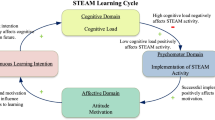Abstract
The Ministry of Education has also actively promoted STEM maker education in recent years. As a result, the maker teaching resources in secondary schools have flourished. STEM is composed of Science, Technology, Engineering and Mathematics. This research mainly introduces STEAM & Maker Education into the class and plans a “STEAM-6E Model” set to incorporate AR/VR Maker Education courses. Learn about theory, application, and implementation through courses. Integrate resources near the school and apply the knowledge learned to solve problems for the community practically. The subjects of the study are 60 high school third-year students in two classes. One class is the experimental group using STEAM-6E teaching and the control group uses traditional briefing teaching, conducting experiments. The MSLQ (Motivated Strategies for Learning Questionnaire) and the ASQ (Activity Satisfaction Questionnaire) are applied to acquire quantitative data for examination. The results showed that the experimental group had differences in learning motivation and satisfaction with learning activities.
Access this chapter
Tax calculation will be finalised at checkout
Purchases are for personal use only
Similar content being viewed by others
References
Barry, N., Burke, D.: 6E Learning by Design Model. Technology and engineering Teacher, 14–19 (2014)
Azuma, R.T.: A survey of augmented reality. Presence: Teleoper. Virtual. Environ. 6(4), 355–385 (1997)
Azuma, R., Baillot, Y., Behringer, R., Feiner, S., Julier, S., MacIntyre, B.: Recent advances in augmented reality. IEEE Comput. Graphics Appl. 21(6), 34–47 (2001)
Eger, J.: The Congressional STEAM Caucus may turn STEM to STEAM in the reauthorization of ESEA. Huffington Post (2015). Recuperado de www.huffingtonpost.com/john-m-eger/stem-may-become-steamoffi_b_8634126.html
Casasanto, V.A., Campbell, B., Manrique, A., Ramsayer, K., Markus, T., Neumann, T.: Lasers, penguins, and polar bears: novel outreach and education approaches for NASA’s ICESat-2 mission. Acta Astronaut. 148, 396–402 (2018)
Kaniawati, D.S., Suryadi, S.: Integration of STEM Education in Learning Cycle 6E To Improve Problem Solving Skills on Direct Current Electricity. Proc. ICMSE 3(1), M-106-M–109 (2016)
Chung, C.C., Lin, C.L., Lou, S.J.: Analysis of the learning effectiveness of the STEAM-6E special course—a case study about the creative design of IoT assistant devices for the elderly. Sustainability 10(9), 3040 (2018)
Perignat, E., Katz-Buonincontro, J.: STEAM in practice and research: an integrative literature review. Thinking Skills Creativ. 31, 31–43 (2019)
Guttentag, D.A.: Virtual reality: Applications and implications for tourism. Tour. Manage. 31(5), 637–651 (2010)
Guerra, J.P., Pinto, M.M., Beato, C.: Virtual reality-shows a new vision for tourism and heritage. Eur. Sci. J. ESJ 11(9), 1–10 (2015)
Fenu, C., Pittarello, F.: Svevo tour: The design and the experimentation of an augmented reality application for engaging visitors of a literary museum. Int. J. Hum Comput Stud. 114, 20–35 (2018)
Keil, J., Zollner, M., Becker, M., Wientapper, F., Engelke, T., Wuest, H.: The House of Olbrich—an augmented reality tour through architectural history. In: 2011 IEEE International Symposium on Mixed and Augmented Reality-Arts, Media, and Humanities (2011)
Lo, J.H., Gong, G.Z.: Touring system using augmented reality-a case study of Yilan cultural industries. In: 2020 3rd IEEE International Conference on Knowledge Innovation and Invention (ICKII), pp. 204–207. IEEE, August 2020
Martínez-Graña, A.M., et al.: Augmented reality in a hiking tour of the Miocene Geoheritage of the central Algarve cliffs (Portugal). Geoheritage 9(1), 121–131 (2017)
Kim, K., Seo, B.K., Han, J.H., Park, J.I.: Augmented reality tour system for immersive experience of cultural heritage. In: Proceedings of the 8th International Conference on Virtual Reality Continuum and its Applications in Industry, pp. 323–324 (2009)
Pintrich, P.R., Smith, D.A., Garcia, T., McKeachie, W.J.: Reliability and predictive validity of the Motivated Strategies for Learning Questionnaire (MSLQ). Educ. Psychol. Measur. 53(3), 801–813 (1993)
Lewis, J.R.: Psychometric evaluation of an after-scenario questionnaire for computer usability studies: the ASQ. ACM Sigchi Bulletin 23(1), 78–81 (1991)
Chang, C. P. A.: Study on the Impact of Using Gamification 6E Model for IoT Hands-on Activity to High School Students’ Learning Attitude, Learning Effectiveness and Behavior Pattern. Master's thesis, National Taiwan Normal University (2020)
Chung, C.C., Lin, C.L.: Research on development of STEAM-6E project course. In: 2018 1st International Cognitive Cities Conference (IC3), pp. 118–122. IEEE (2018)
Lin, C.L., Chiang, J.K.: Using 6E model in STEAM teaching activities to improve university students’ learning satisfaction: a case of development seniors IoT smart cane creative design. J. Internet Technol. 20(7), 2109–2116 (2019)
Author information
Authors and Affiliations
Corresponding author
Editor information
Editors and Affiliations
Rights and permissions
Copyright information
© 2021 Springer Nature Switzerland AG
About this paper
Cite this paper
Lin, YH., Lin, HC.K., Liu, HL. (2021). Using STEAM-6E Model in AR/VR Maker Education Teaching Activities to Improve High School Students’ Learning Motivation and Learning Activity Satisfaction. In: Huang, YM., Lai, CF., Rocha, T. (eds) Innovative Technologies and Learning. ICITL 2021. Lecture Notes in Computer Science(), vol 13117. Springer, Cham. https://doi.org/10.1007/978-3-030-91540-7_13
Download citation
DOI: https://doi.org/10.1007/978-3-030-91540-7_13
Published:
Publisher Name: Springer, Cham
Print ISBN: 978-3-030-91539-1
Online ISBN: 978-3-030-91540-7
eBook Packages: Computer ScienceComputer Science (R0)




